Predicting Stormwater Retention Capacity of Green Roofs: An Experimental Study of the Roles of Climate, Substrate Soil Moisture, and Drainage Layer Properties
Abstract
1. Introduction
2. Materials and Methods
2.1. The Experimental Site and the Monitoring System
2.2. Long Term and Event Scale Climate Characterization
2.3. Methodology
3. Results
RC = −1.53DUR − 4.32DEPTH − 0.21PEAK+0.01VW + 109.62 GR2
4. Conclusions
Author Contributions
Funding
Conflicts of Interest
References
- Rozos, E.; Butler, D.; Makropoulos, C. An integrated system dynamics—Cellular automata model for distributed water-infrastructure planning. Water Sci. Technol. Water Supply 2016, 17, 1519–1527. [Google Scholar] [CrossRef]
- Versini, P.A.; Kotelnikova, N.; Poulhes, A.; Tchiguirinskaia, I.; Schertzer, D.; Leurent, F. A distributed modelling approach to assess the use of Blue and Green Infrastructures to fulfil stormwater management requirements. Landsc. Urban Plan. 2018, 173, 60–63. [Google Scholar] [CrossRef]
- Rozos, E.; Makropoulos, C.; Maksimovic, C. Rethinking urban areas: An example of an integrated blue-green approach. Water Sci. Technol. Water Supply 2013, 13, 1534–1542. [Google Scholar] [CrossRef]
- Mentens, J.; Raes, D.; Hermy, M. Green roofs as a tool for solving the rainwater runoff problem in the urbanized 21st century. Landsc. Urban Plan. 2006, 77, 217–226. [Google Scholar] [CrossRef]
- Li, W.C.; Young, K.K.A. A comprehensive study of green roof performance from environmental perspective. Int. J. Sustain. Built Environ. 2014, 3, 127–134. [Google Scholar] [CrossRef]
- Knapp, S.; Schmauck, S.; Zehnsdorf, A. Biodiversity Impact of Green Roofs and Constructed Wetlands as Progressive Eco-Technologies in Urban Areas. Sustainability 2019, 11, 5846. [Google Scholar] [CrossRef]
- Simmons, M.T.; Gardiner, B.; Windhager, S.; Tinsley, J. Green roofs are not created equal: The hydrologic and thermal performance of six different extensive green roofs and reflective and non-reflective roofs in a sub-tropical climate. Urban Ecosyst. 2008, 11, 339–348. [Google Scholar] [CrossRef]
- Wang, X.; Tian, Y.; Zhao, X.; Peng, C. Hydrological performance of dual-substrate-layer green roofs using porous inert substrates with high sorption capacities. Water Sci. Technol. 2017, 75, 2829–2840. [Google Scholar] [CrossRef]
- Akter, M.; He, J.; Chu, A.; Huang, J.; van Duin, B. A Review of Green Roof Applications for Managing Urban Stormwater in Different Climatic Zones. Sustainability 2018, 10, 2864. [Google Scholar] [CrossRef]
- Schultz, I.; Sailor, D.; Starry, O. Effects of substrate depth and precipitation characteristics on stormwater retention by two green roofs in Portland OR. J. Hydrol. 2018, 18, 110–118. [Google Scholar] [CrossRef]
- Berndtsson, J. Green roof performance towards management of runoff water quantity and quality: A review. Ecol. Eng. 2010, 36, 351–360. [Google Scholar] [CrossRef]
- Chenot, J.; Gaget, E.; Moinardeau, C.; Jaunatre, R.; Buisson, E.; Dutoit, T. Substrate Composition and Depth Affect Soil Moisture Behaviour and Plant-Soil Relationship on Mediterranean Extensive Green Roofs. Water 2017, 9, 817. [Google Scholar] [CrossRef]
- Ferrans, P.; Rey, C.V.; Pérez, G.; Rodriguez, J.P.; Diaz-Granados, M. Effect of Green Roof Configuration and Hydrological Variables on Runoff Water Quantity and Quality. Water 2018, 10, 960. [Google Scholar] [CrossRef]
- Baryla, A.; Karczmarczyk, A.; Bus, A. Role of Substrates Used for Green Roofs in Limiting Rainwater Runoff. J. Ecol. Eng. 2018, 19, 86–92. [Google Scholar] [CrossRef]
- Brandão, C.; Cameira, M.D.R.; Valente, F.; Cruz de Carvalho, R.; Paço, T.A. Wet season hydrological performance of green roofs using native species under Mediterranean climate. J. Ecol. Eng. 2017, 102, 596–611. [Google Scholar] [CrossRef]
- Hilten, R.N.; Lawrence, T.M.; Tollner, E.W. Modeling storm water runoff from green roofs with HYDRUS-1D. J. Hydrol. 2008, 358, 288–293. [Google Scholar] [CrossRef]
- Mobilia, M.; Longobardi, A.; Sartor, J.F. Including A-Priori Assessment of Actual Evapotranspiration for Green Roof Daily Scale Hydrological Modelling. Water 2017, 9, 72. [Google Scholar] [CrossRef]
- Chai, C.T.; Putuhena, F.J.; Selaman, O.S. A modelling study of the event-based retention performance of green roof under the hot-humid tropical climate in Kuching. Water Sci. Technol. 2017, 76, 2988–2999. [Google Scholar] [CrossRef]
- Sartor, J.; Mobilia, M.; Longobardi, A. Results and findings from 15 years of sustainable urban storm water management. Int. J. Saf. Secur. Eng. 2018, 8, 505–514. [Google Scholar] [CrossRef]
- Nawaz, R.; McDonald, A.; Postoyko, S. Hydrological performance of a full-scale extensive green roof located in a temperate climate. Ecol. Eng. 2015, 82, 66–80. [Google Scholar] [CrossRef]
- Soulis, K.X.; Ntoulas, N.; Nektarios, P.A.; Kargas, G. Runoff reduction from extensive green roofs having different substrate depth and plant cover. Ecol. Eng. 2017, 102, 80–89. [Google Scholar] [CrossRef]
- Todorov, D.; Driscoll, C.T.; Todorova, S. Long-term and seasonal hydrologic performance of an extensive green roof. Hydrol. Process. 2018, 32, 2471–2482. [Google Scholar] [CrossRef]
- Sims, A.W.; Robison, C.E.; Smart, C.C.; Voogt, J.A.; Hay, G.J.; Lundholme, J.T.; Powers, B.; O’Carroll, D.M. Retention performance of green roofs in three different climate regions. J. Hydrol. 2016, 542, 115–124. [Google Scholar] [CrossRef]
- Stovin, V.; Vesuviano, G.; Kasmin, H. The hydrological performance of a green roof test bed under UK climatic conditions. J. Hydrol. 2012, 414–415, 148–161. [Google Scholar] [CrossRef]
- Mobilia, M.; Longobardi, A. Smart Stormwater Management in Urban Areas by Roofs Greening. In Computational Science and Its Applications—ICCSA 2017; Gervasi, O., Murgante, B., Misra, S., Borruso, G., Torre, C.M., Rocha, A.M., Taniar, D., Apduhan, B.O., Stankova, E., Cuzzocrea, A., et al., Eds.; Lecture Notes in Computer Science; Springer: Cham, Switzerland, 2007; Volume 1046, pp. 455–463. [Google Scholar]
- Mobilia, M.; D’Ambrosio, R.; Longobardi, A. Climate, soil moisture and drainage layer properties impact on green roofs in a Mediterranean environment. In Frontiers in Water-Energy-Nexus—Nature-Based Solutions, Advanced Technologies and Best Practices for Environmental Sustainability; Naddeo, V., Balakrishnan, M., Choo, K.H., Eds.; Springer: Cham, Switzerland, 2020; pp. 169–171. [Google Scholar]
- Mobilia, M.; Longobardi, A. Event Scale Modeling of Experimental Green Roofs Runoff in a Mediterranean Environment. In Frontiers in Water-Energy-Nexus—Nature-Based Solutions, Advanced Technologies and Best Practices for Environmental Sustainability; Naddeo, V., Balakrishnan, M., Choo, K.H., Eds.; Springer: Cham, Switzerland, 2020; pp. 153–156. [Google Scholar]
- Krasnogorskaya, N.; Longobardi, A.; Mobilia, M.; Khasanova, L.F.; Shchelchkova, A.I. Hydrological Modeling of Green Roofs Runoff by Nash Cascade Model. Open Civ. Eng. J. 2019, 13, 163–171. [Google Scholar] [CrossRef]
- Spectrum Technologies. WaterScout SM 100 Soil Moisture Sensor—Product Manuals; Spectrum Technologies: Plainfield, IL, USA, 2011. [Google Scholar]
- Mobilia, M.; Califano, F.; Longobardi, A. Analysis of rainfall events driving MDHEs occurred in the Solofrana river basin, Southern Italy. Procedia Eng. 2015, 119, 1139–1146. [Google Scholar] [CrossRef]
- Longobardi, A.; Khaertdinova, E. Relating soil moisture and air temperature to evapotranspiration fluxes during inter-storm periods at a Mediterranean experimental site. J. Arid Land 2015, 7, 27–36. [Google Scholar] [CrossRef]
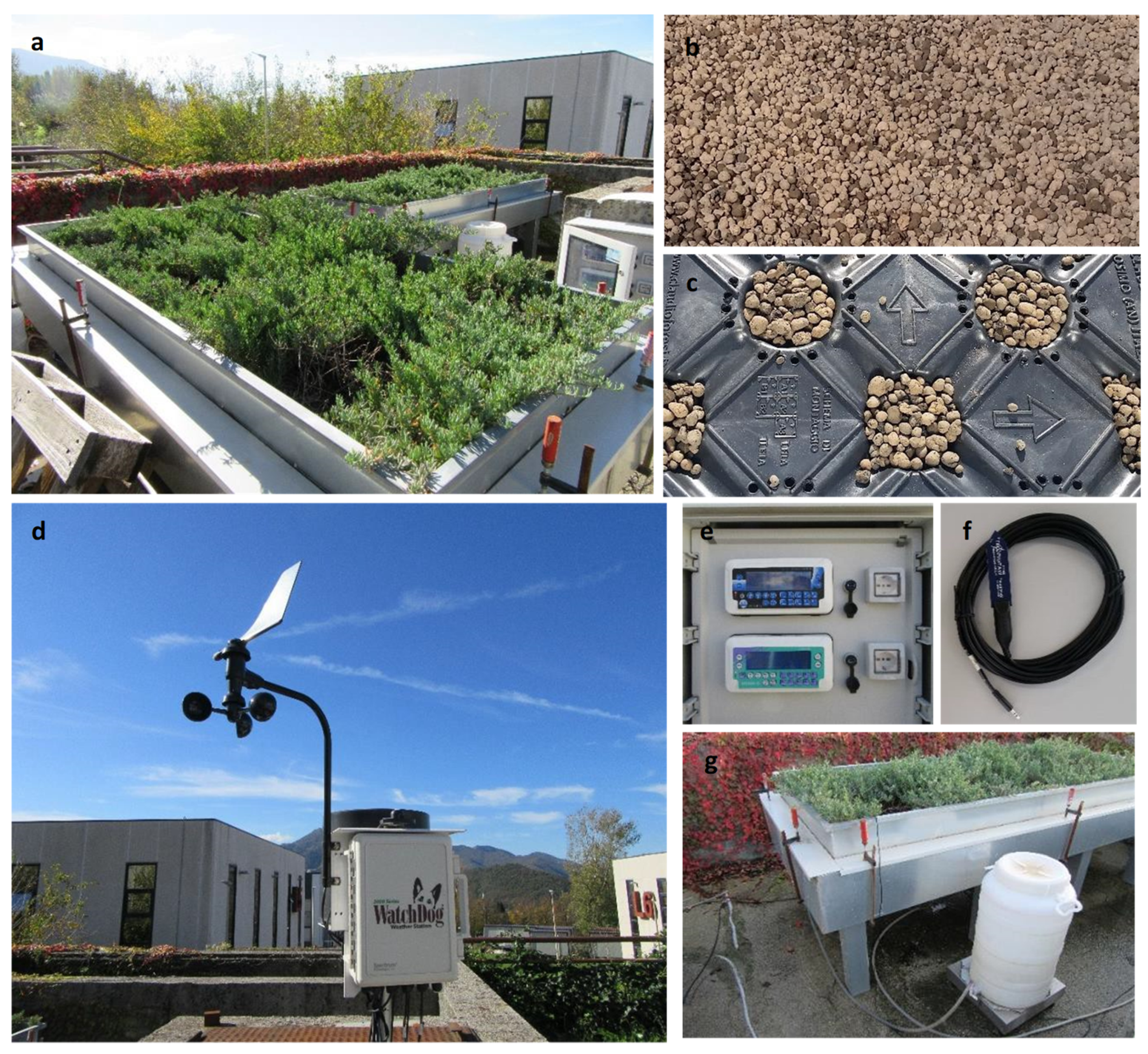
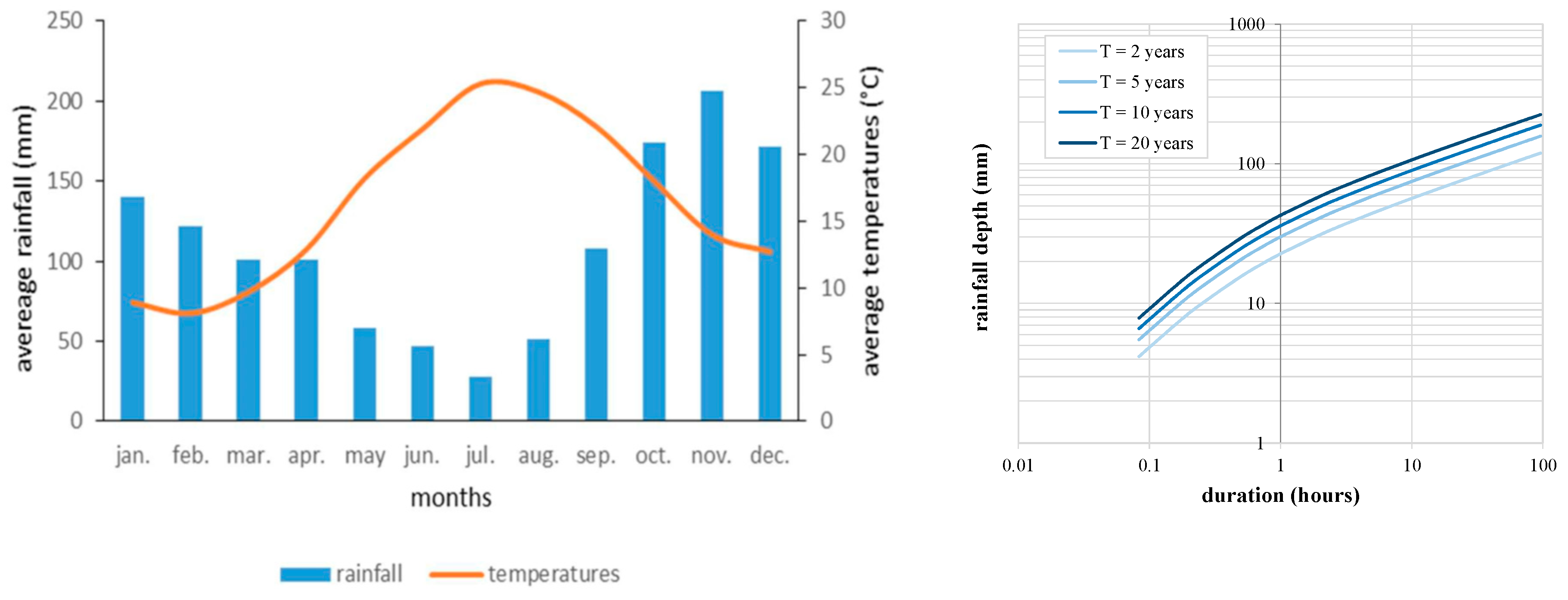
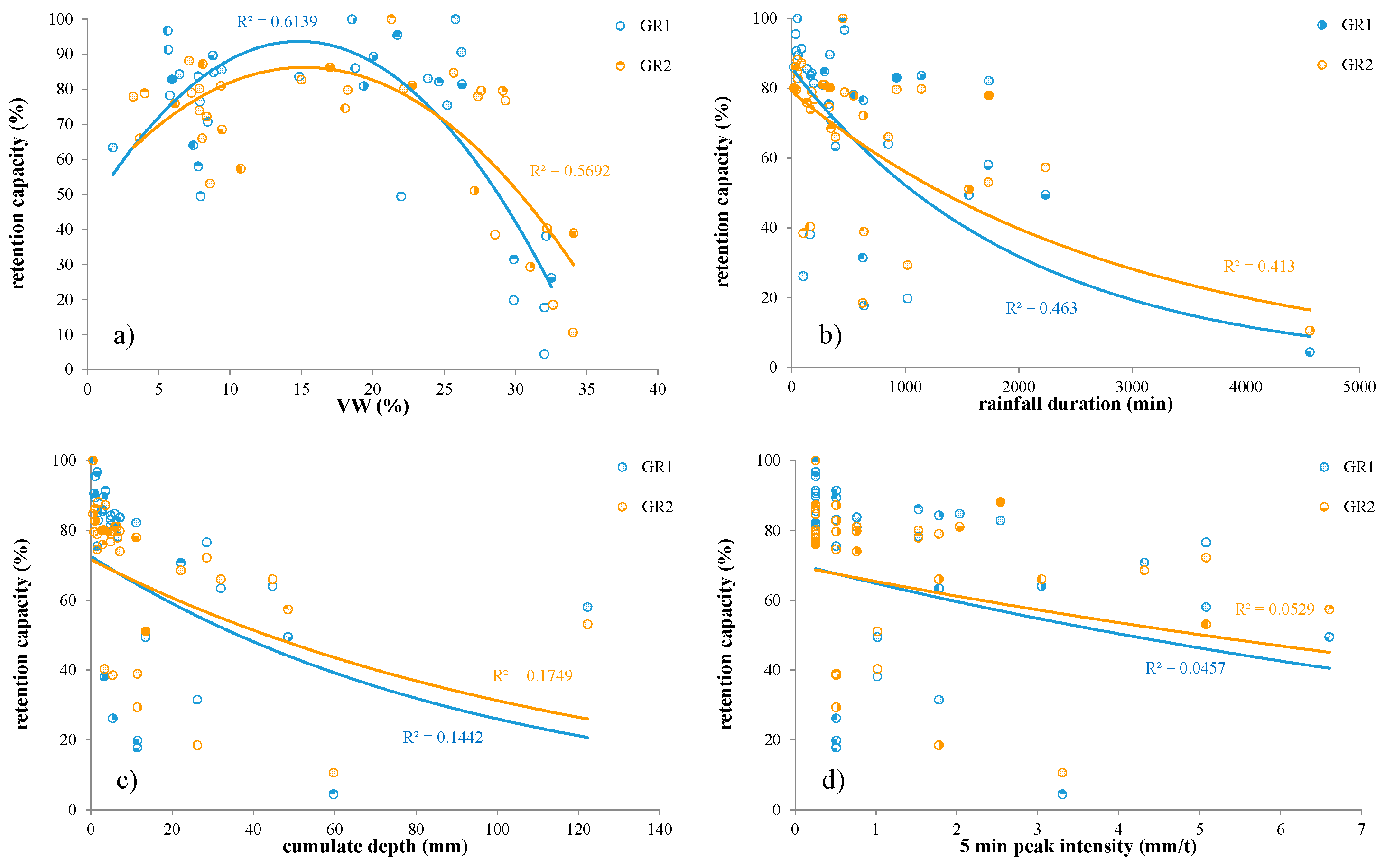

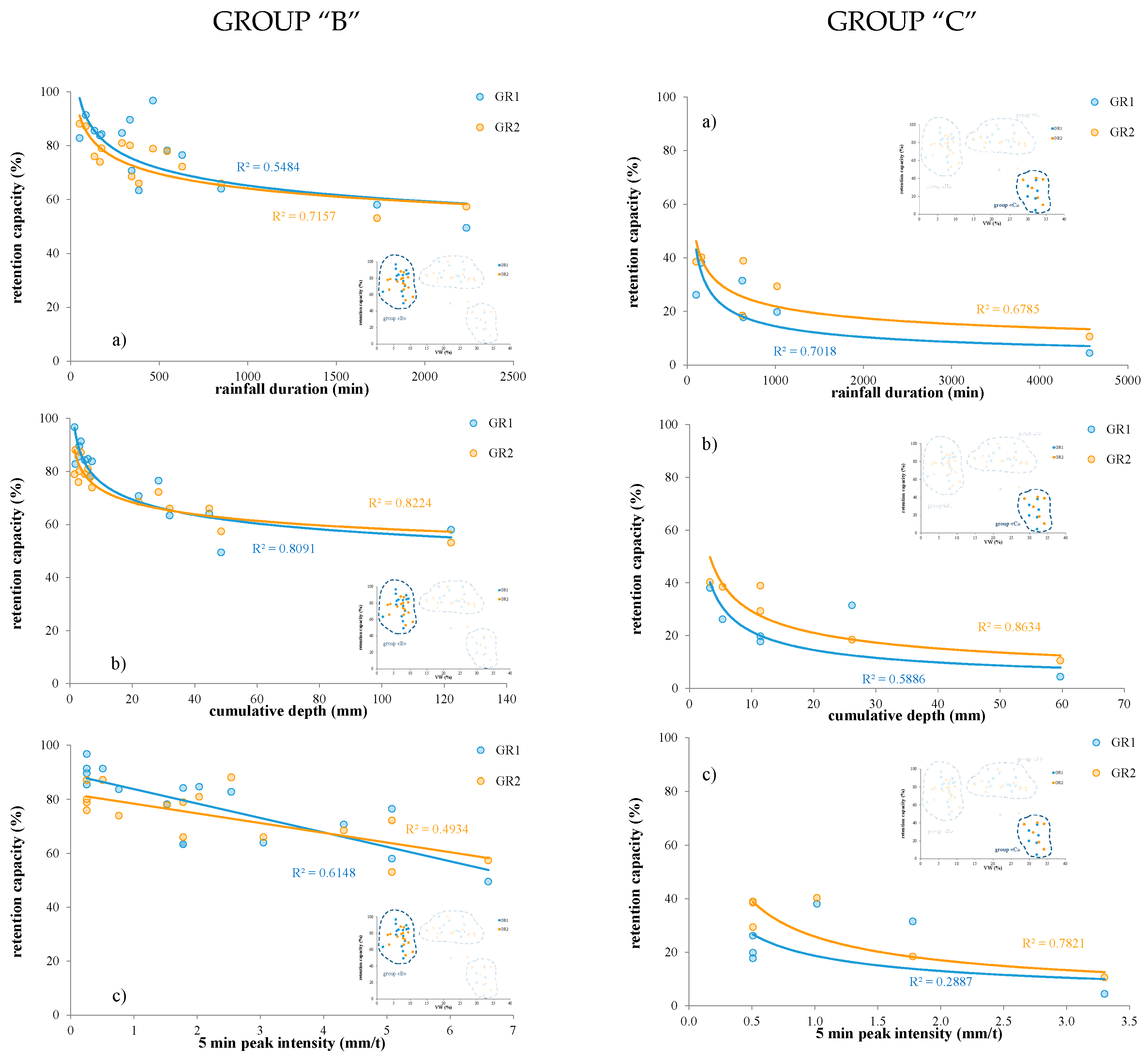

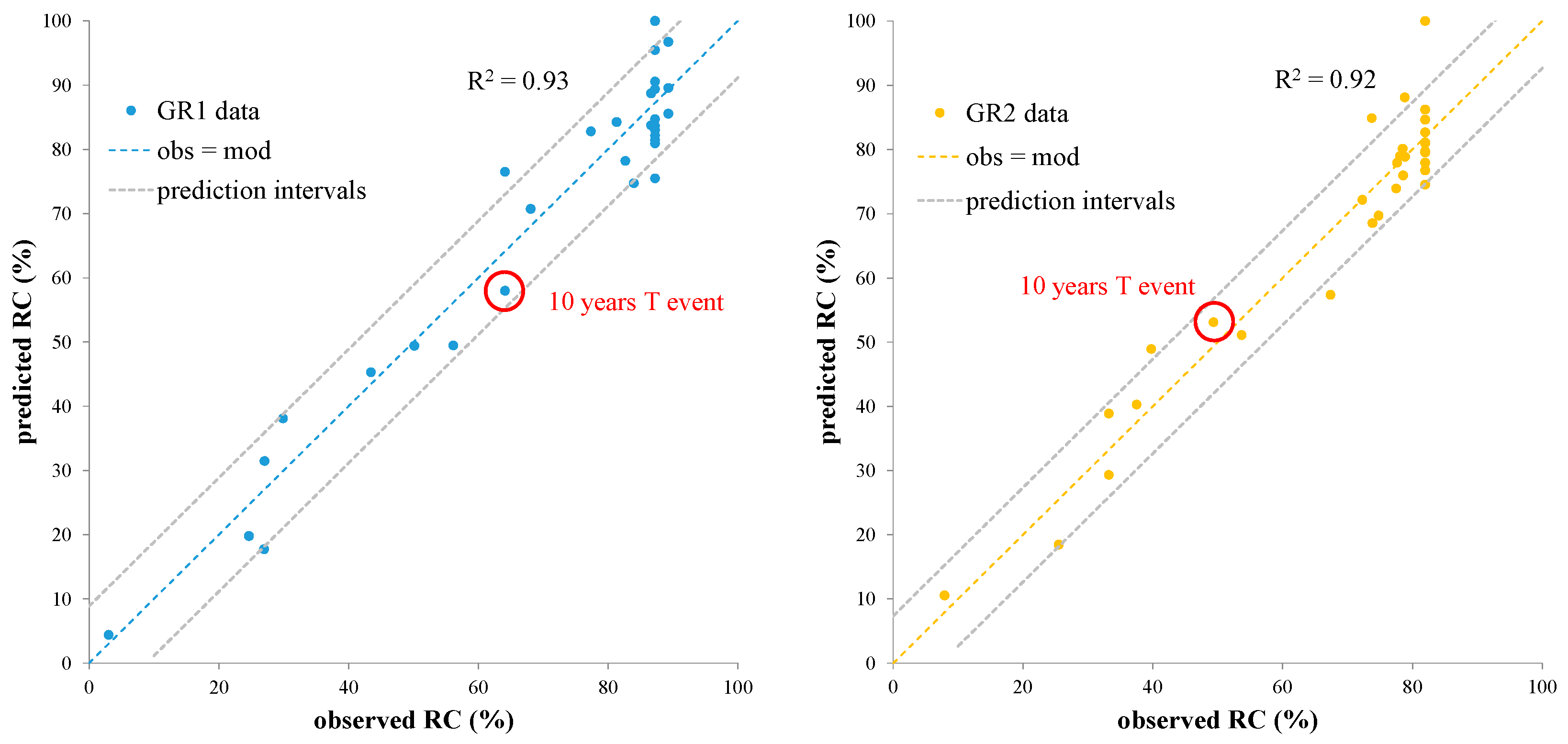
| Event | Duration | Cumulative Rainfall | Peak Intensity |
|---|---|---|---|
| min | mm | mm/5 min | |
| 25/07/2017 | 50 | 1.78 | 2.54 |
| 26/07/2017 | 345 | 22.09 | 4.31 |
| 07/09/2017 | 545 | 6.60 | 1.52 |
| 22/10/2017 | 2235 | 48.51 | 6.60 |
| 21/01/2018 | 625 | 26.16 | 1.77 |
| 01/02/2018 | 1140 | 7.11 | 0.76 |
| 12/02/2018 | 923 | 4.83 | 0.50 |
| 13/02/2018 | 40 | 0.76 | 0.25 |
| 14/02/2018 | 195 | 4.82 | 0.25 |
| 18/02/2018 | 1735 | 11.17 | 0.25 |
| 20/02/2018 | 1020 | 11.43 | 0.50 |
| 02/03/2018 | 160 | 3.30 | 1.01 |
| 03/03/2018 | 635 | 11.43 | 0.50 |
| 04/03/2018 | 4565 | 59.69 | 3.30 |
| 09/04/2018 | 275 | 6.35 | 0.76 |
| 12/04/2018 | 450 | 0.50 | 0.25 |
| 17/04/2018 | 290 | 5.84 | 2.03 |
| 04/05/2018 | 465 | 1.52 | 0.25 |
| 09/05/2018 | 35 | 1.01 | 0.25 |
| 15/05/2018 | 630 | 28.44 | 5.08 |
| 17/05/2018 | 50 | 0.51 | 0.25 |
| 22/05/2018 | 1730 | 122.17 | 5.08 |
| 05/10/2018 | 135 | 2.79 | 0.25 |
| 14/10/2018 | 335 | 3.04 | 0.25 |
| 22/10/2018 | 850 | 44.7 | 3.04 |
| 27/10/2018 | 175 | 4.82 | 1.77 |
| 28/10/2018 | 165 | 7.11 | 0.76 |
| 30/10/2018 | 55 | 1.01 | 0.50 |
| 22/11/2018 | 330 | 1.52 | 0.50 |
| 03/12/2018 | 1560 | 13.46 | 1.01 |
| 08/12/2018 | 20 | 2.79 | 1.52 |
| 11/03/2019 | 385 | 32.00 | 1.77 |
| 12/04/2019 | 100 | 5.33 | 0.50 |
| 22/04/2019 | 85 | 3.55 | 0.25 |
| 22/04/2019 | 85 | 3.55 | 0.50 |
| Event | VW1 | VW2 | RC1 | RC2 |
|---|---|---|---|---|
| % | % | % | % | |
| 25/07/2017 | 5.93 | 7.12 | 83 | 88 |
| 26/07/2017 | 8.43 | 9.44 | 71 | 69 |
| 07/09/2017 | 5.78 | 3.21 | 78 | 78 |
| 22/10/2017 | 7.93 | 10.75 | 49 | 57 |
| 21/01/2018 | 29.90 | 32.65 | 31 | 18 |
| 01/02/2018 | 14.85 | 18.25 | 84 | 80 |
| 12/02/2018 | 23.88 | 27.62 | 83 | 80 |
| 13/02/2018 | 26.23 | 29.12 | 91 | 80 |
| 14/02/2018 | 26.28 | 29.30 | 81 | 77 |
| 18/02/2018 | 24.64 | 27.37 | 82 | 78 |
| 20/02/2018 | 29.89 | 31.06 | 20 | 29 |
| 02/03/2018 | 32.16 | 32.24 | 38 | 40 |
| 03/03/2018 | 32.05 | 34.09 | 18 | 39 |
| 04/03/2018 | 32.04 | 34.06 | 4 | 11 |
| 09/04/2018 | 19.36 | 22.77 | 81 | 81 |
| 12/04/2018 | 18.56 | 21.31 | 100 | 100 |
| 17/04/2018 | 8.85 | 9.36 | 85 | 81 |
| 04/05/2018 | 5.63 | 4.00 | 97 | 79 |
| 09/05/2018 | 21.74 | 17.00 | 95 | 86 |
| 15/05/2018 | 7.89 | 8.35 | 76 | 72 |
| 17/05/2018 | 25.81 | 25.69 | 100 | 85 |
| 22/05/2018 | 7.76 | 8.60 | 58 | 53 |
| 05/10/2018 | 9.42 | 6.13 | 86 | 76 |
| 14/10/2018 | 8.79 | 7.83 | 90 | 80 |
| 22/10/2018 | 7.42 | 8.05 | 64 | 66 |
| 27/10/2018 | 6.44 | 7.29 | 84 | 79 |
| 28/10/2018 | 7.77 | 7.83 | 84 | 74 |
| 30/10/2018 | 20.05 | 15.01 | 89 | 83 |
| 22/11/2018 | 25.24 | 18.06 | 75 | 75 |
| 03/12/2018 | 22.00 | 27.13 | 49 | 51 |
| 08/12/2018 | 18.77 | 22.16 | 86 | 80 |
| 11/03/2019 | 1.78 | 3.66 | 63 | 66 |
| 12/04/2019 | 32.53 | 28.60 | 26 | 38 |
| 22/04/2019 | 5.67 | 8.09 | 91 | 87 |
© 2019 by the authors. Licensee MDPI, Basel, Switzerland. This article is an open access article distributed under the terms and conditions of the Creative Commons Attribution (CC BY) license (http://creativecommons.org/licenses/by/4.0/).
Share and Cite
Longobardi, A.; D’Ambrosio, R.; Mobilia, M. Predicting Stormwater Retention Capacity of Green Roofs: An Experimental Study of the Roles of Climate, Substrate Soil Moisture, and Drainage Layer Properties. Sustainability 2019, 11, 6956. https://doi.org/10.3390/su11246956
Longobardi A, D’Ambrosio R, Mobilia M. Predicting Stormwater Retention Capacity of Green Roofs: An Experimental Study of the Roles of Climate, Substrate Soil Moisture, and Drainage Layer Properties. Sustainability. 2019; 11(24):6956. https://doi.org/10.3390/su11246956
Chicago/Turabian StyleLongobardi, Antonia, Roberta D’Ambrosio, and Mirka Mobilia. 2019. "Predicting Stormwater Retention Capacity of Green Roofs: An Experimental Study of the Roles of Climate, Substrate Soil Moisture, and Drainage Layer Properties" Sustainability 11, no. 24: 6956. https://doi.org/10.3390/su11246956
APA StyleLongobardi, A., D’Ambrosio, R., & Mobilia, M. (2019). Predicting Stormwater Retention Capacity of Green Roofs: An Experimental Study of the Roles of Climate, Substrate Soil Moisture, and Drainage Layer Properties. Sustainability, 11(24), 6956. https://doi.org/10.3390/su11246956







